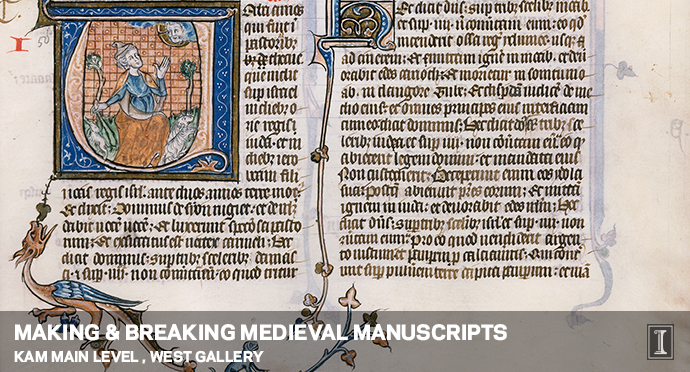
For some of us, marring or damaging a book is unforgivable. Dog-eared pages are a travesty. Pen marks make us cringe. Those little Post-It note flags and residue that they leave behind are also a menace to librarians and purist bibliophiles. But — books are and were meant to be used. We hand them down or give them to friends to borrow. We write our names in them for class or for the family tree. Maybe our addresses or phone numbers are inscribed on the inside cover if it’s a very important book to us. Our actions today are not so different to those of book lovers and owners six to eight centuries ago.
In Making and Breaking Medieval Manuscripts, curators from the Krannert Art Museum and the Rare Books and Manuscript Library (RBML) have brought together a temporary collection of manipulated manuscripts. Marginalia, or images drawn in the margin to accentuate or react to the text, of drollery (amusing figures) and grotesques (usually a human-animal hybrid figure) will be highlighted. Often early books and manuscripts were taken apart. Sometimes they were put back together (or not or simply rebound). Some had pages cut down or apart, or some had images redone or cut out or pasted in from another manuscript. How the object has changed over time is always an interesting story.
Along with Making and Breaking Medieval Manuscripts, the Spurlock Museum has their ongoing exhibition on Medieval Irish manuscripts. Entitled Medieval Irish Manuscripts with Modern Reproduction, the exhibition showcases museum-quality reproductions of early Irish metalwork pieces as part of the late nineteenth and early twentieth century Celtic revival. The objects, on view until April 2, 2017, are shown alongside Irish vernacular and Latin manuscripts from the University’s library.
If you haven’t guessed already, the University of Illinois has a lot of manuscripts between the Spurlock, KAM, and RBML. Both exhibitions are a nice complement to each other. One tells a broad story about manuscripts as historic objects and as part of collections. The other tells a story about decorative objects reproduced as part of a revival and interest in illuminated manuscripts and other historical texts.
 In order to learn more about Making and Breaking Medieval Manuscripts, I e-mailed Maureen Warren, curator of European and American Art at the KAM, a few questions.
In order to learn more about Making and Breaking Medieval Manuscripts, I e-mailed Maureen Warren, curator of European and American Art at the KAM, a few questions.
———
Smile Politely: In five words, can you describe Making and Breaking Medieval Manuscripts?
Maureen Warren: Making, re-making, and cutting up manuscripts.
SP: What is the overall objective or thought behind the exhibition? I assume the exhibit’s theme is about the making of manuscripts, but also how some are taken apart, cut down, or re-used over time.
Warren: The exhibition traces the long life history of manuscripts, not only how they are made, which includes issues of concerning patronage, artistic process, and the impact of the printing press, but also how manuscripts were used, modified, collected, broken into pieces, and even how bookbreaking in the 19th and 20th centuries created a market for manuscript forgeries.
SP: I see that the exhibition has manuscripts from KAM’s collections, but also the University of Illinois’ Rare Books and Manuscripts Library, the Spurlock Museum, and Chicago’s Newberry Library. Was it difficult or easy to collaborate with three other institutions in order to acquire the manuscripts that you needed or wanted for the exhibition?
Warren: All of the manuscripts in the exhibition are owned in full or part by the University of Illinois Urbana-Champaign. As you would expect, it is easiest for KAM to get access to works from RBML and Spurlock Museum, because our staff members collaborate frequently and we are all part of the same institution. In practical terms it means that there is less paperwork and the transportation is easier to coordinate. Cher Schneider and Quinn Ferris, two fantastic conservators at the university library’s Conservation Lab, have done a lot of work to support the exhibition, including treating objects, building cradles, matting flat works, calculating the amount of silica gel needed to condition each case (to control humidity), and helping to install the artwork. The two items coming from the Newberry Library are co-owned by the university. From this year forward, they and the three other works that are co-owned will come to campus a few months each year so that scholars and students will have access to them. These objects were a bit more difficult to coordinate to include in the exhibition, but are well worth the effort.
SP: As a follow-up, did you have to make any concessions or make any interesting replacements? From personal experience, I remember how frustrating or difficult it can be to find a replacement exhibit object when the registrar or collections manager says the original exhibit object can’t travel or be displayed at the last minute.
Warren: We did end up removing at least two items from the exhibition due to issues related to conservation. With one of the books, the binding was too tight and the first page had come loose. We wanted to show that page, but were concerned that having the book open for three months might further damage the binding. Luckily, our list of objects was already too long, so cutting two items was not a problem.
SP: Is there a manuscript or two that stands out to you that visitors should seek out?
Warren: This is a tough question! I imagine that my co-curator, Anna Chen, would probably choose different items. For me, there are several real standouts. One is the “Ordo ad consecrandum et coronandum regem et reginam Franciae,” a 14th-century coronation book made for someone close to Queen Jeanne d’Evreux. I love this manuscript because it gives us an intimate glimpse of a medieval coronation ceremony in a lavish format. It has elegant script and beautiful gold-leafed miniatures showing the king and queen. This book has actually been digitized by the [university’s] library, and while digital images are not as good as the real thing they give you an idea of how sumptuous it is.
Another wonderful object in the exhibition is a sixteenth-century portolan chart of the Mediterranean, which has been attributed to Catalan mapmaker Bartolomé Olives. Portolan charts are detailed, highly accurate maritime maps, which have with the names of port cities written along the coast and little dots to indicate rocks and other sailing hazards. Some were made for navigation at sea and others were decorative showpieces. This object is important because it gives us a glimpse of the Mediterranean at a time of global expansion and exploration. In fact, many of the pigments used in medieval manuscripts–examples of which (loaned from artist Randy Asplund) can be seen in the exhibition in a case near this map–were only available because of global trade. For example, lapis lazuli, used to make costly ultramarine blue, was traded from Afghanistan and brazil lake was made from the sawdust of the Brazilwood (Caesalpinia) tree, which French and Portuguese traders bribed and forced Tupinamba people in present-day Brazil to collect.
There are so many more objects in the exhibition that I think people will really enjoy [the exhibition], but I will leave it at that and invite you and others to come and find your own favorites!
—
Making and Breaking Medieval Manuscripts opens on Thursday November 17th. There will be a private preview reception starting at 5:00 p.m. for members and a public reception from 6:00 p.m. to 7:00 p.m. with an opening welcome from KAM Director and Acting Dean of the College of Fine and Applied Arts Kathleen Harleman.
Prior to the exhibition’s opening, however, there will be a Medieval Studies lecture on Wednesday November 16th. Maria Luisa Meneghetti of the University of Milan’s Department of Literary Studies, Linguistics, and Philology will present “Illuminated Rooms Between History and Legend: From the Middle Ages to Arisoto” in the KAM Auditorium (a.k.a. Room 62) at 5:30 p.m. Her talk will focus on a historical and prophetic fresco cycle mentioned in the Italian romance Orlando Furioso by Ludovico Ariosto. Later in February Carol Symes will give another Medieval Studies Lecture tied to the exhibition.
Medieval Irish Manuscripts in Modern Reproduction available until April 2, 2017. The Spurlock’s exhibition. On Sunday November 19th, the Zahn Learning Center will have Bookbinding and decoration with Kells stamps from 1:00 p.m. to 4:00 p.m. As part of their Open Hours series, visitors can participate in the craft for $2. On December 3rd at 2:00 p.m., there will be a tour of the exhibition by exhibit curator Professor Charles Wright. Additional programming associated with the exhibition can be found at the Spurlock’s website.
Images used with permission of Krannert Art Museum.








